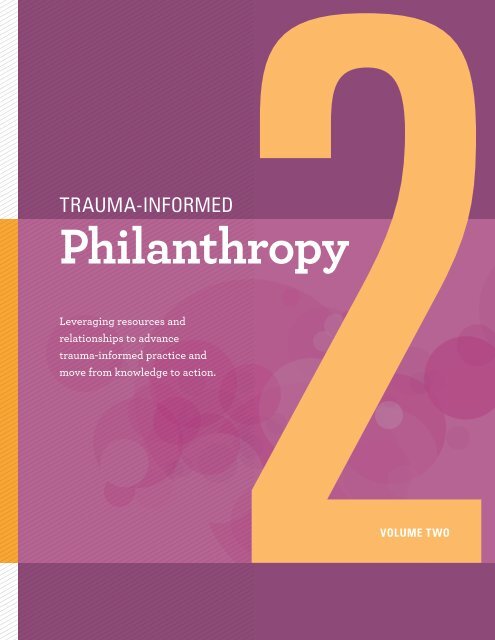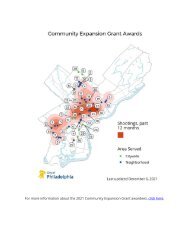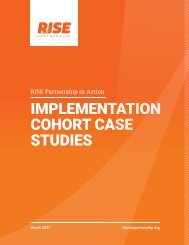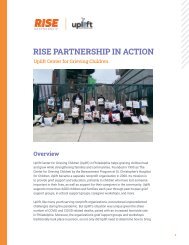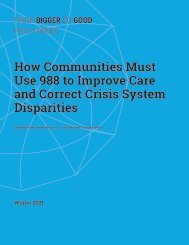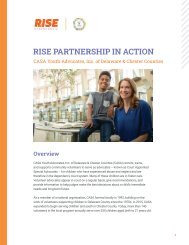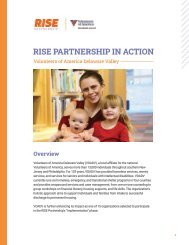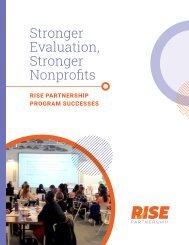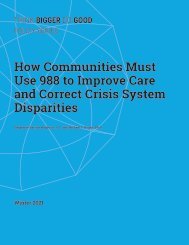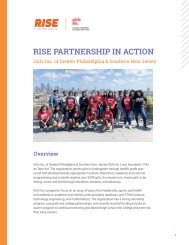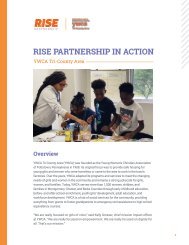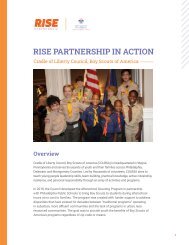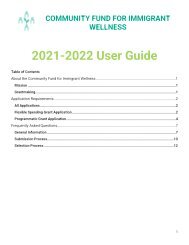Trauma-Informed Philanthropy Vol2
You also want an ePaper? Increase the reach of your titles
YUMPU automatically turns print PDFs into web optimized ePapers that Google loves.
2<br />
TRAUMA-INFORMED<br />
<strong>Philanthropy</strong><br />
Leveraging resources and<br />
relationships to advance<br />
trauma-informed practice and<br />
move from knowledge to action.<br />
VOLUME TWO
contents<br />
THE TRAUMA-INFORMED<br />
PHILANTHROPY SERIES<br />
In October 2016, United Way of Greater Philadelphia<br />
and Southern New Jersey (UWGPSNJ), the<br />
Thomas Scattergood Behavioral Health Foundation,<br />
and <strong>Philanthropy</strong> Network Greater Philadelphia<br />
partnered to develop and release <strong>Trauma</strong>-<strong>Informed</strong><br />
<strong>Philanthropy</strong>: A Funder’s Resource Guide to <strong>Trauma</strong>-<br />
<strong>Informed</strong> Practice in the Delaware Valley (Greater<br />
Philadelphia). This guide laid the groundwork for<br />
funders to understand how trauma contributes to<br />
poor health and social outcomes across the lifespan<br />
and provided initial ideas for applying a traumainformed<br />
lens to philanthropy.<br />
The guide helped funders to:<br />
» Understand the science behind trauma, adverse<br />
childhood experiences (ACEs), and resilience;<br />
» Apply trauma-informed principles and practices<br />
to grantmaking; and<br />
» Learn about existing local efforts to implement<br />
trauma-informed practice.<br />
Volume Two builds on the knowledge and skills<br />
presented in the first Funder’s Resource Guide.<br />
Lessons learned from leading local and national<br />
efforts provide insights for advancing the traumainformed<br />
movement in Greater Philadelphia.<br />
Specifically, this guide will help funders to:<br />
» Incorporate a trauma-informed approach<br />
into their grantmaking;<br />
» Foster collaboration and cross-sector<br />
networks; and<br />
TABLE OF CONTENTS<br />
Introduction........................................................................................................3<br />
Vision for a <strong>Trauma</strong>-<strong>Informed</strong> Region..................................................3<br />
Opportunities for <strong>Philanthropy</strong> to<br />
Advance the <strong>Trauma</strong>-<strong>Informed</strong> Movement .......................................4<br />
Part One: <strong>Trauma</strong>-<strong>Informed</strong> Grantmaking .................................................7<br />
Investing in <strong>Trauma</strong>-<strong>Informed</strong> Practice..............................................7<br />
Key Principles for <strong>Trauma</strong>-<strong>Informed</strong> Grantmaking...........................8<br />
Implementation Profiles .......................................................................10<br />
Children’s Crisis Treatment Center................................................12<br />
Stephen and Sandra Sheller<br />
11th Street Family Health Services...............................................14<br />
Lakeside Therapeutic Schools.......................................................16<br />
Youth Sentencing and Reentry Project........................................18<br />
Kensington <strong>Trauma</strong>-<strong>Informed</strong><br />
Community Development Partnership ........................................ 20<br />
Cross-Cutting Domains........................................................................ 22<br />
Part Two: Fostering Collaboration<br />
and Cross-Sector Networks ...................................................................... 26<br />
Why is Collaboration Important?....................................................... 26<br />
Building Cross-Sector Networks ...................................................... 28<br />
The Role of <strong>Philanthropy</strong> ..................................................................... 31<br />
Part Three: Building the Field Through Evaluation .............................. 33<br />
Why is Evaluation Important? ............................................................ 33<br />
Evaluating <strong>Trauma</strong>-<strong>Informed</strong> Practice ............................................ 34<br />
The Role of <strong>Philanthropy</strong>...................................................................... 35<br />
» Build the field through evaluation.
vision for a trauma-informed region<br />
Communities in Greater Philadelphia will be safe, healthy, and<br />
prosperous. Knowledge and awareness of trauma-informed practice<br />
will permeate the culture. Residents will have access to supports and<br />
resources to achieve optimal physical and mental health, wellness,<br />
and success. Well-established networks will connect cross-sector<br />
partnerships — public and private, for-profit and nonprofit — that<br />
will benefit the entire region.<br />
The Greater Philadelphia funding community will work in partnership<br />
to set a national example for investing in and advancing traumainformed<br />
practice across all sectors. In doing so, Greater Philadelphia<br />
will become renowned for its success in improving health, well-being,<br />
and prosperity of the region’s most vulnerable citizens.<br />
Introduction 3
opportunities for philanthropy to advance the<br />
trauma-informed movement<br />
Funders have a<br />
responsibility<br />
to understand<br />
how trauma and<br />
ACEs impact our<br />
community, and to<br />
support programs<br />
in all sectors to<br />
promote healing<br />
and resilience.<br />
The science is clear – the effects of trauma and adversity build up over the human lifespan,<br />
contributing to inequitable outcomes in every area of life. We now understand that trauma is<br />
pervasive and experienced on individual, group, and societal levels. We also know that some<br />
effects can pass from generation to generation.<br />
Across sectors, this awareness is transforming service delivery, policy, and community<br />
engagement. Organizations and collective efforts leading the trauma-informed movement<br />
recognize the potential to dramatically improve outcomes for children, vulnerable adults,<br />
families, and communities.<br />
Flexibility to develop new approaches is vital as we translate the science of resilience into<br />
practice. Yet public funding contracts often demand evidence-tested models and accountability<br />
measures that reinforce structural inequities and leave little space for revolutionary action.<br />
Private foundations can play a vital role in addressing this gap.<br />
We have the opportunity to accelerate emerging approaches by deploying resources in<br />
creative ways to support risk, while building knowledge and capacity. Funders can also<br />
leverage relationships by serving as conveners and influential champions, especially with<br />
sectors like government and business.<br />
The trauma-informed approach will look different for each individual, organization, community,<br />
and system. This guide is not a “how to,” but hopefully serves a starting point for reflection and<br />
action. We do not have all the answers, but encourage you to strive with us because ultimately,<br />
the trauma-informed movement has significant potential to increase the efficacy of every grant<br />
and begin to dismantle systemic inequities.<br />
Joe Pyle, President<br />
Thomas Scattergood<br />
Behavioral Health Foundation<br />
Bill Golderer, President & CEO<br />
United Way of Greater<br />
Philadelphia and Southern<br />
New Jersy<br />
Sidney R. Hargro,<br />
Executive Director<br />
<strong>Philanthropy</strong> Network<br />
Greater Philadelphia<br />
4 Introduction
Integrating a trauma-informed lens takes time, requires<br />
vigilance, and raises difficult questions. <strong>Trauma</strong> touches<br />
every socioeconomic group, race, ethnicity, gender, and<br />
sexual identity, yet is disproportionately experienced by<br />
low-income communities, communities of color, LGBTQ<br />
communities, and women. As we work to address trauma,<br />
we must account for these long-standing structural<br />
inequities. Recognizing historical trauma adds to our<br />
understanding of community context and our ability to<br />
effect positive social change.<br />
All Foundation staff and trustees should understand the<br />
science of trauma and resilience, then together consider<br />
how a trauma-informed lens may apply across all aspects<br />
of the Foundation’s work.<br />
To help build a trauma-informed region, philanthropy’s<br />
most powerful levers of change include:<br />
» Incorporating a trauma-informed approach into<br />
grantmaking practices and priorities;<br />
» Fostering cross-sector collaboration and networks<br />
that bring together multiple stakeholders working to<br />
advance trauma-informed care; and<br />
» Building the field though evaluation, both to<br />
demonstrate impact and to increase knowledge about<br />
effective practices and models.<br />
HOW NEW IDEAS SPREAD<br />
Study of the Diffusion of Innovations<br />
provides insights for the traumainformed<br />
movement’s efforts to promote<br />
new ways of thinking and practices<br />
across sectors.<br />
Innovations spread via social networks<br />
and many different communication<br />
channels. Early adopters often influence<br />
other opinions.<br />
Looking at the factors that influence the adoption of innovations, trauma-informed<br />
practice has the following benefits and challenges:<br />
» Understanding the impact of trauma<br />
provides Relative Advantage to<br />
human services professionals who<br />
have felt barriers to change.<br />
» Champions see Compatibility with<br />
the tenets of trauma-informed<br />
practice, as consistent with their<br />
past experiences, values, and needs.<br />
» The Complexity of trauma-informed<br />
language and concepts can be<br />
challenging; clear definitions of core<br />
elements are needed.<br />
» Key areas to develop include more<br />
Trialable and Observable strategies<br />
to prove the positive impact of a<br />
trauma-informed approach, which<br />
can stimulate further discussion.<br />
» Implementation across sectors<br />
leads to Re-Invention that helps<br />
innovations diffuse faster and<br />
increases the likelihood of sustained<br />
change, since adopters can<br />
customize an innovation to fit their<br />
unique situation.<br />
Adapted from Diffusion of Innovations 1<br />
Introduction 5
“We are standing on the cusp of a new revolution, and it is every bit<br />
as consequential as the one sparked by Pasteur’s discovery of germs. ”<br />
— Nadine Burke Harris, The Deepest Well<br />
WHAT’S THE BIG DEAL ABOUT TRAUMA AND ADVERSITY?<br />
A NOTE FROM SANDRA BLOOM<br />
Why is it necessary to change our point<br />
of view, to make the deep changes we<br />
are suggesting? When you read the<br />
Vision for a <strong>Trauma</strong>-<strong>Informed</strong> Region,<br />
it was not difficult to agree with the<br />
aspirations. However, it is harder to<br />
imagine the “How do we get there<br />
from here?” After all, philanthropic<br />
and service organizations have been<br />
trying for a very long time to achieve<br />
such aspirational goals. But we haven’t<br />
reached them — not even close. Lack<br />
of money? Lack of effort? No. Lack of<br />
knowledge? Partly.<br />
Until recently we have been missing<br />
some critical information — the serious,<br />
complex, and lifelong consequences<br />
of exposure to trauma and adversity,<br />
especially when it begins in childhood.<br />
This lack of knowledge has meant our<br />
explanations for human misbehavior,<br />
dysfunction, and illness have<br />
inadvertently kept systems divided,<br />
confused, and unable to meaningfully<br />
collaborate. Each human services<br />
field comes with its own language and<br />
assumptions that inform how they work.<br />
Depending on which part of the system<br />
a client is engaged with, they may be<br />
viewed as bad or sick, irresponsible or<br />
not responsible, victim or perpetrator, or<br />
any of a number of other dichotomized<br />
labels that do not capture the whole<br />
person or their context. The result<br />
is a widespread, systemic problem<br />
best described by the metaphor of the<br />
Tower of Babel, at its heart a story<br />
about human miscommunication and<br />
confusion.<br />
The big deal about trauma and adversity<br />
is that we now understand the ways<br />
human beings can be injured from before<br />
birth until death.<br />
We have new insight into how injuries<br />
to genes, bodies, and minds interact<br />
to produce an array of problems and<br />
maladjustments as well as creative<br />
adaptations, transformations, and<br />
growth that affect subsequent<br />
generations. This new knowledge opens<br />
up possibilities to inform health care and<br />
mental health care; child welfare and<br />
supports for vulnerable adults; primary,<br />
secondary, and higher education;<br />
community-based services and criminal<br />
justice services. We now can all start<br />
from a common knowledge base with<br />
shared assumptions, methodologies, and<br />
goals. In doing so, we begin to consider<br />
the whole human being in the context<br />
of his or her family, community, culture,<br />
and society. That’s what we mean when<br />
we call for “trauma-informed change.”<br />
And that kind of deep change is what we<br />
mean by a “paradigm shift” — a change<br />
in the very basic mental models that<br />
inform how we make sense of the world.<br />
6 Introduction
1PART ONE<br />
<strong>Trauma</strong>-<strong>Informed</strong> Grantmaking<br />
investing in trauma-informed<br />
practice<br />
This section outlines key<br />
principles for bringing a traumainformed<br />
lens to funding processes<br />
and showcases model efforts<br />
to implement trauma-informed<br />
practice in the region, highlighting<br />
different sectors and operational<br />
domains. Core ingredients seen<br />
across these efforts suggest<br />
factors grantmakers should look<br />
for when making investment<br />
decisions.<br />
Research tells us that trauma can alter human development and functioning.<br />
<strong>Trauma</strong>-informed practice seeks to translate this science to inform services and<br />
address root causes of social challenges. Through grant priorities and investment<br />
decisions, funders can encourage the adoption of trauma-informed practice. A<br />
trauma lens is instructive for grants to any type of social program and does not<br />
require a separate, new funding priority. Ideally, philanthropy would support<br />
programs in all sectors that promote healing and resilience.<br />
Distinguishing between services that utilize brain science to shape practice and<br />
those which do not can be difficult. While some standards for trauma-informed<br />
care exist in particular sectors or localities, most are designed as guidance rather<br />
than strict requirements. Checklists or other inflexible criteria are not sufficient<br />
to capture the complexity of trauma-informed change efforts. Implementing this<br />
approach requires ongoing commitment at all levels and evolves over time, going<br />
beyond specific services or staff to cross all aspects of nonprofit operations.<br />
<strong>Trauma</strong>-<strong>Informed</strong> Grantmaking 7
key principles for<br />
trauma-informed grantmaking<br />
A true investment in traumainformed<br />
practice will require<br />
funders to inventory their own<br />
policies and procedures to ensure<br />
alignment with a trauma lens.<br />
Adapting the six principles of<br />
trauma-informed practice from<br />
the Substance Abuse and Mental<br />
Health Services Administration<br />
(SAMHSA) 2 and The Sanctuary<br />
Model’s Seven Commitments, 3<br />
core tenets for trauma-informed<br />
grantmaking include:<br />
1<br />
ACKNOWLEDGEMENT OF POWER STRUCTURES<br />
Funders hold the power to make decisions about which organizations<br />
and programs receive funding and which do not — a tremendous<br />
responsibility. This power shapes which communities receive services,<br />
what programs are developed, and how those programs are implemented.<br />
Systemic power structures are grounded in historical and structural<br />
inequities and often reinforced by siloed and inadequate funding streams.<br />
Funders must acknowledge and wield their power with care and attention<br />
to these inequities.<br />
2DIVERSITY, EQUITY, AND INCLUSION<br />
and partners.<br />
Promoting leadership and inclusion of marginalized groups is necessary<br />
to bringing about social justice. Diversity, equity, and inclusion are vital<br />
considerations in both internal hiring practices and in selecting grantees<br />
3EMPOWERMENT AND VOICE<br />
On-the-ground perspectives are crucial to successful social change.<br />
Ensuring that community organizations, service providers, and consumers<br />
have a voice in determining community needs, priorities, and strategies<br />
of change increases the potential for impact.<br />
4<br />
PATIENCE AND FLEXIBILITY<br />
All too often, funders place strict requirements on grantees within rigid,<br />
inflexible timelines. Although transformative social change requires time,<br />
risk-taking, and learning from failure, philanthropic organizations rarely<br />
give grantees the time and space to make mistakes, learn, and grow.<br />
Unrealistic time constraints and expectations set up grantees for failure,<br />
leaving the communities they serve without needed services. With<br />
increased patience and flexibility, community organizations and service<br />
providers will have the necessary breathing room to provide services<br />
that make an impact.<br />
8 <strong>Trauma</strong>-<strong>Informed</strong> Grantmaking
5<br />
CREATIVITY AND RISK TAKING<br />
<strong>Philanthropy</strong> cannot solve complex social problems alone, but can deploy<br />
available resources to fund new and innovative programs. Without the<br />
burden of accountability to the taxpayer, philanthropy can fund bold, and<br />
even risky, initiatives. While evidence-based practices have value, we also<br />
need to make room for emerging practices to be implemented and studied so<br />
they can be taken to scale. This is a unique role philanthropy can play that<br />
could ultimately change service provision more broadly.<br />
6TRANSPARENCY<br />
For much of the nonprofit community, why and how programs do or do not<br />
receive funding is confusing and unclear. Demystifying the process by which<br />
funding decisions are made is integral to helping the nonprofit sector utilize<br />
their existing resources effectively.<br />
7<br />
RESPONSIVENESS<br />
Though grant cycles can provide structure, they can limit a funder’s ability<br />
to make swift decisions when crises emerge or as new information arises.<br />
Additionally, long waiting periods between application deadlines and award<br />
notifications can make planning difficult for nonprofits. Making discretionary<br />
grants available to alleviate pressing issues can help communities to be<br />
more responsive to specific needs.<br />
8<br />
LISTENING AND HUMILITY<br />
Encouraging honest and thoughtful feedback from your grantees and the<br />
communities they serve can help to correct the power imbalance in the<br />
funder-grantee relationship. Take the time to understand the full range of<br />
your grantees’ needs and be self-reflective of how philanthropy’s demands<br />
and restrictions may make it difficult for service providers to be effective.<br />
<strong>Trauma</strong>-<strong>Informed</strong> Grantmaking 9
implementation profiles<br />
In addition to providing background information on<br />
trauma and ACEs, Volume One of the <strong>Trauma</strong>-<strong>Informed</strong><br />
<strong>Philanthropy</strong> series introduced SAMSHA’s six principles<br />
for trauma-informed organizations and how those might<br />
apply to grantmaking.<br />
SAMHSA’S<br />
10 IMPLEMENTATION<br />
DOMAINS<br />
FOR A<br />
TRAUMA-INFORMED<br />
APPROACH<br />
Volume Two seeks to provide further guidance, utilizing<br />
SAMHSA’s 10 Implementation Domains 4 to explore<br />
specific areas where trauma-informed principles can be<br />
operationalized. The following profiles of local traumainformed<br />
change efforts provide examples of how<br />
organizations have implemented trauma-informed principles<br />
in the various domains. These stories are intended for use<br />
as guidance for organizations seeking to weave traumainformed<br />
practices into their work.<br />
10 <strong>Trauma</strong>-<strong>Informed</strong> Grantmaking
Governance<br />
and Leadership:<br />
Board and executive leadership support<br />
and show strong investment in the<br />
implementation of trauma-informed<br />
practice throughout the organization.<br />
Policy:<br />
The trauma-informed approach<br />
is woven into an organization’s<br />
policies and protocols (internal). The<br />
organization accounts for the broader<br />
policy context and works to address<br />
structural and systemic barriers<br />
(external).<br />
Physical<br />
Environment:<br />
The organization’s physical environment<br />
promotes a sense of physical and<br />
psychological safety for both staff and<br />
individuals receiving services.<br />
Engagement and<br />
Involvement:<br />
Individuals receiving services have<br />
meaningful involvement in all levels of<br />
decision making, from program planning<br />
through evaluation.<br />
Cross Sector<br />
Collaboration:<br />
The organization works with service<br />
providers in other sectors to promote<br />
trauma-informed practice and more<br />
effectively address the multifaceted,<br />
interdependent needs of vulnerable<br />
community members.<br />
6<br />
Screening,<br />
Assessment,<br />
Treatment Services<br />
Service providers have training and<br />
use interventions which reflect traumainformed<br />
principles, are based in<br />
the best available evidence, and are<br />
culturally sensitive. Screening and<br />
assessment for trauma and resilience<br />
are utilized as a vital part of the<br />
organization’s service continuum.<br />
Training and Workforce<br />
Development:<br />
Staff have ongoing training<br />
and professional development.<br />
Organizations acknowledge and<br />
seek to address issues of secondary<br />
traumatic stress, vicarious trauma, and<br />
compassion fatigue.<br />
8<br />
4<br />
1<br />
Progress Monitoring<br />
and Quality Assurance:<br />
The organization measures indicators<br />
related to quality of care and progress<br />
in implementing trauma-informed<br />
principles.<br />
9<br />
Financing:<br />
Financing structures support the<br />
implementation of holistic traumainformed<br />
practice.<br />
10<br />
Evaluation:<br />
The organization shows a commitment<br />
to measuring and continually<br />
improving the efficacy of its services.<br />
Evaluation and research designs<br />
reflect principles of trauma-informed<br />
practice and cultural competence.<br />
<strong>Trauma</strong>-<strong>Informed</strong> Grantmaking 11
Journey to <strong>Trauma</strong>-<strong>Informed</strong> Practice:<br />
Children’s Crisis Treatment Center<br />
Stage of Implementation:<br />
10+ years<br />
Sector:<br />
Behavioral Health<br />
Children’s Crisis Treatment Center (CCTC) delivered<br />
trauma-focused treatment and interventions for more<br />
than fifteen years before launching a comprehensive<br />
organizational change process in 2006.<br />
About the Organization:<br />
Children’s Crisis Treatment Center (CCTC)<br />
specializes in behavioral health services<br />
that address the impact of child abuse,<br />
neglect, traumatic events, and other<br />
challenges to early childhood development.<br />
CCTC’s services help Philadelphia’s<br />
children and families reach their full<br />
potential in their homes, communities,<br />
and society. CCTC has been a recognized<br />
trailblazer in institutionalizing traumainformed<br />
approaches and organizational<br />
practices. Embarking on the Sanctuary<br />
process more than 10 years ago, CCTC<br />
was one of the first organizations to apply<br />
Sanctuary principles to services beyond<br />
residential behavioral health. Antonio<br />
Valdes, Chief Executive Officer, and<br />
Grace Ryder, Director of Best Practices<br />
and Strategic Initiatives, have led this<br />
work since its launch in 2006.<br />
Key Implementation Domains:<br />
Policy (Internal)<br />
Progress Monitoring<br />
and Quality Assurance<br />
12 Implementation Profiles
Interest, opportunity, and resources came together<br />
for senior leaders to attend the Sanctuary Institute<br />
training. Seeing the potential for shared language and<br />
an established framework to guide change aligned<br />
with their organizational values, CCTC launched<br />
the Sanctuary implementation process. Sanctuary<br />
certification was only part of this organizational change<br />
process. Executive and program leaders represented<br />
on CCTC’s Sanctuary Implementation Committee have<br />
continued to meet every other week since, a reflection<br />
of the journey that Antonio Valdes and Grace Ryder say<br />
is never complete but continues to evolve over time.<br />
Early wins helped establish a strong foundation<br />
and sustain the model at CCTC, including activating<br />
champions among non-clinical staff. If some areas<br />
of organizational work drifted off course, established<br />
trauma-informed programs provided strong models to<br />
re-align implementation. CCTC maintains and renews<br />
their Sanctuary commitment via ongoing training and<br />
continued work to ensure management and service<br />
delivery align with core principles. Documented<br />
policies expanded as the organization grew, then<br />
recent revisions used a Sanctuary lens to review<br />
everything from human resources materials to CCTC’s<br />
reimbursement policy. Legal considerations dictated<br />
that some wording stay in place, but much of the<br />
language shifted to emphasize process and humanize<br />
approaches — for example, replacing “client”<br />
with “kids and families.” Such changes in language<br />
reflected and helped to advance renewed efforts<br />
to engage consumers and families in advisory and<br />
leadership capacities.<br />
Strengths-based practices and commitment to including<br />
voices from all perspectives, especially those with<br />
lived experience, extend to the organization’s quality<br />
assurance and improvement systems as well. Service<br />
planning and outcome measures identify child, family,<br />
and community strengths, and track changes in<br />
resiliency factors such as connections to community<br />
resources and social supports. CCTC’s Family Advisory<br />
Board engages caregivers in organizing activities,<br />
providing feedback, and sending parent representatives<br />
to the agency’s Quality Management Committee<br />
and Sanctuary Implementation Committee. Quality<br />
management involves parent representatives and staff<br />
from various levels, including building services, in a<br />
monthly review of organizational issues with a strong<br />
trauma-informed lens focused especially on addressing<br />
any safety issues.<br />
Implementation Profiles 13
Journey to <strong>Trauma</strong>-<strong>Informed</strong> Practice:<br />
Steven and Sandra Sheller<br />
11th Street Family Health Services<br />
Stage of Implementation:<br />
10+ years<br />
Sector:<br />
Health Care<br />
The 11th Street Family Health Services Center (11th Street)<br />
grew from a twenty-year partnership between Drexel<br />
University’s College of Nursing and Health Professions<br />
and residents of public housing developments near 11th<br />
Street in lower North Philadelphia.<br />
About the Organization:<br />
Drexel University’s 11th Street Family<br />
Health Services (11th Street) provides<br />
a single point of access for integrated<br />
primary care, behavioral health, dental<br />
services, and health and wellness<br />
programs serving more than 6,000<br />
patients annually. Since beginning work<br />
in the neighborhood in 1998, Patricia<br />
Gerrity of Drexel’s School of Nursing<br />
and Health Professions has intentionally<br />
partnered with community groups and<br />
residents of the four nearby Philadelphia<br />
Housing Authority complexes. 11th<br />
Street’s Director of Health and Wellness,<br />
John Kirby, supports the health center’s<br />
continued evolution, including recent<br />
efforts to train Community Advisory<br />
Board members to spread awareness<br />
about the consequences of trauma and<br />
ACEs on health and well-being.<br />
Key Implementation Domains:<br />
Engagement and Involvement<br />
Financing<br />
14 Implementation Profiles
Now a leading national model for nurse-led,<br />
community-based health care, 11th Street<br />
has incorporated authentic community engagement<br />
into every stage of service planning and delivery.<br />
Committed to delivering health services that respond<br />
to community-identified needs, 11th Street works with<br />
residents and other community stakeholders through the<br />
Partnership for Community Based Care. From the outset,<br />
the Partnership listened to the community first and then<br />
designed services. Residents were initially distrustful —<br />
universities had come to study the neighborhood in the<br />
past but left few resources behind. The Partnership<br />
aimed to do business differently, with a goal of working<br />
with the community to build “a place of their own” to<br />
improve community health.<br />
Gerrity knew the College of Nursing was “making a<br />
long-term commitment, but needed short-term wins.”<br />
Community trust grew when Gerrity’s team responded<br />
to issues identified through initial conversations, like<br />
neighborhood concerns about cars disregarding stop<br />
signs and bite risks from roaming stray dogs. Other<br />
strategies that boosted initial momentum included<br />
connecting with resident council leaders as key<br />
community champions, involving all ages in gathering<br />
data, and sharing findings with the community. 11th<br />
Street’s Community Advisory Board members have been<br />
highly valued and engaged stakeholders. Members<br />
played a significant role in the recent expansion and<br />
redesign of the clinic, bringing tremendous expertise to<br />
that process.<br />
To gain Federally Qualified Health Center status in<br />
2002, 11th Street partnered with Family Practice and<br />
Counseling Network. Drexel faculty and staff bring<br />
complementary programs, leveraging resources as a<br />
teaching facility. Through this partnership, 11th Street<br />
aligned funding streams behind the scenes to offer<br />
holistic health and well-being supports with a “no<br />
wrong door” approach for community members.<br />
11th Street embarked on Sanctuary work with Sandra<br />
Bloom in 2008, after identifying a common thread of<br />
trauma histories among neighborhood residents with<br />
depression and hypertension. While Sanctuary brought<br />
a guiding framework, implementation in a health care<br />
setting was a new arena and required shared learning<br />
over subsequent years.<br />
Building on Sanctuary implementation and ongoing<br />
community engagement, 11th Street is equipping<br />
Community Advisory Board members to spread<br />
knowledge as ambassadors for the trauma-informed<br />
movement. In recent years, the Community Advisory<br />
Board participated in trainings about brain architecture,<br />
the impact of stress, and ACEs. Members now share<br />
this knowledge with other neighborhood residents and,<br />
as part of the Philadelphia ACE Task Force, the local<br />
trauma-informed cross-sector network.<br />
Implementation Profiles 15
Journey to <strong>Trauma</strong>-<strong>Informed</strong> Practice:<br />
Lakeside Therapeutic Schools and Services<br />
Stage of Implementation:<br />
10+ years<br />
Sector:<br />
Education<br />
Lakeside has provided alternative education and support<br />
for youth with behavioral challenges and/or involved in the<br />
courts system for more than 30 years.<br />
About the Organization:<br />
Lakeside’s four therapeutic schools<br />
located in Montgomery County, PA, utilize<br />
a brain-based, trauma-informed approach<br />
that contributes to students’ academic,<br />
emotional, social, and behavioral success<br />
by providing a therapeutic learning<br />
experience balanced with support<br />
and nurturing. Small classes, intensive<br />
counseling, individualized planning,<br />
and partnerships with parents are key<br />
elements of each school. Gerry Vassar,<br />
President/CEO of Lakeside Educational<br />
Network, and Kathy Van Horn, Executive<br />
Vice President, have worked together for<br />
many years to build and refine Lakeside’s<br />
Therapeutic Schools. <strong>Trauma</strong>-informed<br />
interventions have been part of school<br />
services for more than 10 years, with a<br />
special focus on somatosensory supports<br />
for the past five.<br />
Key Implementation Domains:<br />
Physical Environment<br />
Screening, Assessment, and<br />
Treatment Services<br />
16 Implementation Profiles
Establishing stable funding mechanisms while giving<br />
educators space to figure out what works for youth<br />
has been essential to Lakeside schools’ success.<br />
As Kathy Van Horn explains, “We work hard to build a<br />
different kind of relationship with students, because<br />
we get that punishment does not work for youth with<br />
trauma histories — we have to teach young people to<br />
respond differently.” Guided by this belief, Lakeside’s<br />
therapeutic schools focus on increasing students’<br />
abilities to self-regulate emotional responses that<br />
can hijack learning, evident in school facilities and<br />
throughout the student experience.<br />
Lakeside provides school districts in the region with<br />
alternative placement options through advance tuition<br />
payment contracts, a funding structure which allowed<br />
Lakeside to develop a responsive educational model.<br />
About 75 percent of the model had been tested and refined<br />
by the early 2000s. But there were common underlying<br />
needs left unaddressed, until staff learned about the<br />
neurosequential model for therapeutics (NMT). Key to this<br />
model is an understanding that children who experience<br />
trauma often operate in a state of hypervigilance, which<br />
impedes their ability to access higher-order thinking and<br />
demands treatment and calming techniques for human’s<br />
lower “reptile” brain.<br />
After attending NMT training funded by UWGPSNJ,<br />
Lakeside leaders incorporated a variety of sensory<br />
supports in their schools. Every classroom has rocking<br />
or bounce chairs and at least one stand up desk available,<br />
as well as quiet corners and separate rooms that students<br />
are encouraged to use when they need a break. Students<br />
check and record their pulse when entering and before<br />
leaving quiet spaces, determining on their own when<br />
ready to return to class. Posters throughout each<br />
building reinforce brain-based techniques that foster<br />
self-regulation.<br />
Intake, assessment, and tracking progress for each<br />
student at Lakeside schools also incorporate traumainformed<br />
elements. After reviewing referral information,<br />
service plans, and testing, Lakeside schools establish a<br />
collaborative agreement with the student, parents, and<br />
home school district. To ensure complete and up-to-date<br />
information, Lakeside assesses academic skill levels and<br />
student learning styles, and uses the Achenbach System<br />
of Empirically Based Assessment (ASEBA) for pre/post<br />
assessment of behavioral health. Each student has a case<br />
manager who completes a psychosocial assessment<br />
through conversation over time to avoid overwhelming<br />
the student with personal questions after initial academic<br />
assessments. They also complete a NMT metric that<br />
helps to structure and sequence interventions. Lakeside’s<br />
discipline system relies on positive behavioral supports,<br />
including a point system and collaborative problem solving<br />
to help students think through solutions, then brings in<br />
additional resources as needed.<br />
Student supports also include coordinating therapeutic<br />
services, including drug and alcohol counseling. Equipping<br />
students with skills to help them succeed after returning to<br />
their home school is key to transition planning. To support<br />
Lakeside’s holistic approach, both teaching and clinical<br />
staff have extensive training upon hire and in subsequent<br />
years. Teachers also have time after each school day to<br />
debrief, collaborate, and problem solve about how to best<br />
meet youth needs. Regular supervision and strong social<br />
connections also help Lakeside educators avoid burnout<br />
and stay focused.<br />
Implementation Profiles 17
Journey to <strong>Trauma</strong>-<strong>Informed</strong> Practice:<br />
Youth Sentencing and Reentry Project<br />
Stage of Implementation:<br />
Two to four years<br />
Sector:<br />
Criminal Justice<br />
About the Organization:<br />
The Youth Sentencing & Reentry Project<br />
(YSRP) is a Philadelphia-based nonprofit<br />
that supports youth prosecuted in the<br />
adult criminal justice system, including<br />
individuals sentenced as children to<br />
life without parole (“juvenile lifers“). In<br />
partnership with court-involved youth<br />
and juvenile lifers, their families, and<br />
lawyers, YSRP develops comprehensive<br />
life history narratives and reentry plans<br />
that mitigate the facts of each case and<br />
inform sentencing. Ultimate goals are to<br />
keep children out of adult prisons and<br />
to enhance the quality of representation<br />
juvenile lifers receive at resentencing,<br />
while supporting both as they prepare<br />
to reenter the community. Co-founders<br />
Lauren Fine and Joanna Visser Adjoian<br />
launched YSRP three and a half<br />
years ago.<br />
The Youth Sentencing & Reentry Project (YSRP) works in<br />
partnership with court-involved youth and juvenile lifers,<br />
their families, and lawyers to get cases transferred to the<br />
juvenile system or resentenced. During this process and<br />
to support reentry, YSRP connects client-partners to<br />
community resources for education, health care, housing,<br />
and employment.<br />
Key Implementation Domains:<br />
Cross-Sector Collaboration<br />
Policy (External)<br />
18 Implementation Profiles
YSRP’s core beliefs are that justice requires that context<br />
be considered at sentencing and that all young people<br />
deserve to have options and opportunities on the other<br />
side of a bad situation. Through past work at Juvenile<br />
Law Center, YSRP co-founders saw how often courtinvolved<br />
youth had no space to provide even basic<br />
information to the attorney charged with protecting their<br />
freedom. “The justice system focuses on momentary<br />
snapshots of youth as people and provides a very black<br />
and white response to something much more nuanced.<br />
How do we better understand behavior and choices,<br />
and make better, more individualized responses to<br />
hurt?” asks Lauren Fine. Answering this question<br />
involves providing more holistic information about each<br />
situation, while helping judges and lawyers understand<br />
the impact of childhood trauma.<br />
Since starting as a two-person endeavor, Fine and Visser<br />
Adjoian have amplified YSRP’s impact by leveraging<br />
partnerships and maintaining focus on both individual<br />
cases and system changes. Attorneys, including public<br />
defenders and private counsel, are eager to work with<br />
YSRP to introduce comprehensive case histories into<br />
evidence, seeing an opportunity to more fully represent<br />
young clients. Exploring earned income strategies to<br />
sustain the organization, YSRP is starting to receive<br />
some small payments as a contributing party to the<br />
defense team, particularly in cases with juvenile<br />
lifers. YSRP engages students and other volunteers to<br />
assist in the work and provides trainings on mitigation<br />
to attorneys, judges, graduate students, and other<br />
volunteers. Through these strategies, YSRP works to<br />
shift the culture of the criminal justice system, expand<br />
resources available to low-income youth of color who<br />
come in contact with the system, and to train new<br />
generations of lawyers and social workers.<br />
Building on their individual casework, YSRP partners<br />
with policy and advocacy organizations to drive broader<br />
systems change. As common issues and “pain points”<br />
for young people, juvenile lifers, and their families<br />
emerge, YSRP connects with policy groups which<br />
advocate for legislative and regulatory action. This<br />
way, the advocacy process involves those with lived<br />
experience, bringing about policy change that avoids<br />
tokenizing and re-traumatizing YSRP’s client-partners.<br />
Costs for custody in Philadelphia’s juvenile justice<br />
system has been one area of early advocacy success<br />
for YSRP. After learning of the practice of charging<br />
families for their child’s juvenile justice placement, YSRP<br />
set out to eliminate this disincentive for families to be<br />
in the juvenile justice system, which is better equipped<br />
to address their educational, health care, emotional,<br />
and development needs. YSRP partnered with Temple’s<br />
Sheller Center Justice Lab, whose students conducted<br />
research that became the basis of the campaign. Letters<br />
to the editor and conversations with Philadelphia’s<br />
Department of Human Services contributed to the City<br />
declaring a moratorium and forgiving accrued charges<br />
to families for juvenile justice placements.<br />
Implementation Profiles 19
Journey to <strong>Trauma</strong>-<strong>Informed</strong> Practice:<br />
Kensington <strong>Trauma</strong>-<strong>Informed</strong> Community<br />
Development Partnership<br />
Stage of Implementation:<br />
Less than two years<br />
Sector:<br />
Community Development<br />
About the Organization:<br />
Philadelphia’s Greater Kensington<br />
area* reflects the city’s post-industrial<br />
decline and uneven regeneration.<br />
Since the 1980s, Kensington has been<br />
characterized by social challenges<br />
including being ground zero of<br />
the region’s opioid epidemic. As<br />
gentrification arrives in southern<br />
Kensington, northern expanses still<br />
face alarming health and well-being<br />
outcomes. Two organizations in the<br />
region — Impact Services and New<br />
Kensington Community Development<br />
Corporation (NKCDC) — joined forces<br />
with Philadelphia Local Initiatives<br />
Support Corporation (LISC) in 2016 to<br />
launch a comprehensive development<br />
effort with trauma-informed community<br />
building at the center. The vision for<br />
this effort grew from Impact Services’<br />
CEO Casey O’Donnell’s past work in<br />
child welfare and with Veteran Affairs’<br />
National Council on PTSD.<br />
An outgrowth from informal conversations between various<br />
community organizations working to bring a trauma lens<br />
to neighborhood-level efforts, Impact Services and New<br />
Kensington Community Development Corporation (NKCDC)<br />
saw an opportunity to build on complementary efforts.<br />
Key Implementation Domains:<br />
Cross-Sector Collaboration<br />
Evaluation<br />
* Including portions of the 19125, 19134,<br />
and 19124 zip codes<br />
20 Implementation Profiles
NKCDC had documented resident stories through a<br />
project with Motivos magazine and discovered common<br />
themes about trauma and challenges to community<br />
resilience. Impact Services had initial success in<br />
implementing trauma-informed work with veterans and<br />
in workforce development that it sought to expand to<br />
community-wide development.<br />
After extensive discussions with LISC, Kensington<br />
became part of LISC’s Sustainable Communities Initiative<br />
(SCI) in 2016. The SCI model engages local stakeholders<br />
in determining priorities and working together to<br />
revitalize neighborhoods. In Kensington, SCI builds<br />
on two neighborhood development plans completed<br />
separately with funding from Wells Fargo Regional<br />
Foundation. SCI efforts focus on increasing access<br />
to services and improving physical assets, while also<br />
developing a community-building model that counters<br />
the multifaceted impacts of trauma for residents of<br />
disinvested neighborhoods. LISC works intentionally<br />
as a learning partner, exploring how trauma-informed<br />
approaches can inform community development and<br />
how to translate relevant information to that field. Both<br />
NKCDC and Impact Services are actively working to<br />
expand trauma-informed practices throughout their own<br />
organizations, as well as through this collaboration.<br />
Collaboration requires continual communication and<br />
renegotiating of goals and roles between the partners<br />
as work moves forward. This ongoing dialogue was<br />
essential after leadership changes at NKCDC, to transfer<br />
knowledge of work underway and to ensure buy-in.<br />
The partners have been intentional in recognizing<br />
power dynamics, especially when they have included<br />
funder-partners. Acknowledging power differentials<br />
has played an integral role in maintaining open, honest<br />
communication — a key element of strong collaboration.<br />
Each partner shares a commitment to strive for safety<br />
and respect for all voices.<br />
Fostering resident ownership and leadership in<br />
community development is an area where traumainformed<br />
perspectives hold significant promise.<br />
LISC helped bring in additional resources from the<br />
Scattergood Foundation to support this goal. The<br />
Kensington partners are working with Philadelphiabased<br />
trauma experts and neighborhood representatives<br />
to co-design a block-based community engagement<br />
strategy to build social cohesion and foster resiliency.<br />
Developing a turn-around training curriculum remains a<br />
core goal, though learning through the process led to a<br />
shift — to not just deliver trainings, but also to establish<br />
a network of community leaders who can continue the<br />
work with support from partner organizations.<br />
In spring 2018, resident leaders will review the draft<br />
trauma-informed Community Connectors curriculum<br />
and give feedback. The curriculum will also incorporate<br />
a trauma-informed lens to “tried and true” community<br />
engagement strategies and help gauge organizational<br />
and community readiness. Researchers are working<br />
alongside residents and project partners through a<br />
participatory evaluation approach, adapting existing<br />
measures of collective efficacy and testing if the<br />
measures capture the impact of the work and can inform<br />
refinements. Reflecting on the need to accept a degree<br />
of ambiguity while creating a community-driven process<br />
and evaluation, project co-leader Zoë Van Orsdol shared,<br />
“We feel like we’re on the right path. We’re not sure<br />
where that path leads yet, but we are learning together.”<br />
Implementation Profiles 21
cross-cutting domains<br />
Across all of the highlighted organizations, three major<br />
themes emerged as crucial factors for implementing traumainformed<br />
practice:<br />
» Leadership<br />
» Culture Change<br />
» Continual Knowledge-Building<br />
In addition to the implementation domains highlighted in<br />
the profiles, these cross-cutting domains provide additional<br />
guidance for funders when considering investment<br />
decisions.<br />
LEADERSHIP<br />
Executive-level commitment is crucial to launching<br />
and sustaining trauma-informed organizational change.<br />
Such transformation requires significant staff time and<br />
effort, so organizational leaders must make the process<br />
an ongoing priority.<br />
Equally important is expanding the base of champions and<br />
implementation drivers from all levels of the organization. As<br />
CCTC’s Grace Ryder shared, “Executive leaders’ consistent<br />
presence as champions is vital, and so is growing leadership<br />
throughout the organization. We were involved in every step<br />
at the beginning, then have worked consciously to empower<br />
other champions to take on pieces of the work. That’s the<br />
only way it can grow; no one person can do all.”<br />
“Understanding trauma is not just about<br />
acquiring knowledge. It’s about changing<br />
the way you view the world.”<br />
—Sandra Bloom<br />
22 <strong>Trauma</strong>-<strong>Informed</strong> Grantmaking
“Sanctuary became the new cultural norm<br />
for this place, how we do business.”<br />
— Antonio Valdes, Children’s Crisis Treatment Center<br />
Because leadership and staff transitions are inevitable,<br />
building champions throughout the organization is critical.<br />
During times of transition, having at least one “keeper<br />
of the vision” to intentionally support the transfer of<br />
knowledge and experience helps to sustain momentum.<br />
Should major transitions occur, partners must revisit shared<br />
commitments, roles, and benefits to mitigate potential areas<br />
of misalignment.<br />
CULTURE CHANGE<br />
Leaders across the region caution against considering<br />
trauma-informed change efforts as limited to discrete<br />
program efforts or specific therapeutic staff.<br />
Applying a trauma-informed approach requires shifts<br />
at all levels of operations and a significant commitment<br />
of time and resources. At each organization profiled,<br />
trauma-informed work evolved and expanded to additional<br />
program areas over time, creating a ripple effect of change<br />
throughout the agency.<br />
Organizing frameworks can help organizations and systems<br />
move through the complicated change process of shifting<br />
culture and practices at all levels. At CCTC and 11th Street<br />
Health Services, The Sanctuary Model provided guiding<br />
principles and a comprehensive implementation model.<br />
For Lakeside, Bruce Perry’s Neurosequential Model for<br />
Therapeutics provides the organizing framework that<br />
informs their educational approach, as well as student<br />
assessment and supports.<br />
<strong>Trauma</strong>-informed culture change requires attention to<br />
governance and management, intentional use of language,<br />
and supporting the workforce to carry out trauma-informed<br />
interventions.<br />
To support safety and continual learning within<br />
organizations, a commitment to transparent, democratic<br />
governance and management is crucial. CCTC emphasizes<br />
that how organizations manage difficult decisions and work<br />
through challenges is critical to being trauma-informed.<br />
When tough decisions must be made, all levels of staff<br />
should feel that their voices are considered. Organizations<br />
must also engage constituents and community stakeholders<br />
in their decision-making process.<br />
<strong>Trauma</strong>-<strong>Informed</strong> Grantmaking 23
Language is also a key element of culture that reflects<br />
organizational mindset. The profiled organizations are<br />
intentional in the language each uses to describe their<br />
work, both internally and externally. CCTC reviewed<br />
all organizational policies and procedures through a<br />
Sanctuary lens, making revisions to reframe technical<br />
language to be more positive and mission-focused. YSRP’s<br />
language reflects their strengths-based approach, using<br />
“client-partner” in all communications. Case statements<br />
shared with the courts incorporate strengths and<br />
resources, as well as trauma narratives.<br />
Supporting the human services workforce and<br />
buffering against vicarious trauma is also integral to<br />
a trauma-informed approach. In the fall of 2015, 11th<br />
Street Health Services formally adopted a Culture of<br />
Mindfulness, providing staff with regular access to<br />
mindfulness, yoga, relaxation, fitness, and art therapy.<br />
Kensington Partners highlighted how staff who spend most<br />
of their work time in the neighborhood, crossing paths with<br />
pervasive challenges of addiction and disrepair, experience<br />
a particular drain on their energy. Acknowledging<br />
this reality is part of shared support through informal<br />
check-ins and more formal processing. Kensington<br />
staff, as well as practitioners at CCTC and educators<br />
at Lakeside Therapeutic Schools, all benefit from<br />
regularly scheduled supervision.<br />
“Folks who are incarcerated are traumatized by not being able to tell<br />
their story. We work to bring in assets and aspirations, while being<br />
careful to share the nuance of each situation and avoid the risk<br />
of pathologizing entire communities.”<br />
— Joanna Visser Adjoian, Youth Sentencing Reentry Project<br />
24 <strong>Trauma</strong>-<strong>Informed</strong> Grantmaking
CONTINUAL KNOWLEDGE-BUILDING<br />
For organizations implementing trauma-informed approaches,<br />
constantly expanding and revisiting learning at all levels of the<br />
workforce is crucial.<br />
Leaders from the profiled organizations emphasized the<br />
importance of participation for all levels of staff, even<br />
building services workers. Each organization has regularly<br />
scheduled opportunities for ongoing training and education<br />
— both on- and off-site.<br />
Knowledge and insights for trauma-informed practice come<br />
from other on the ground sources as well. During initial<br />
planning, 11th Street gave children cameras to capture<br />
neighborhood scenes and worked together to understand<br />
the implications for community health. Kensington Partners<br />
co-designed trainings with community leaders, in addition to<br />
working with an academic partner through a participatory<br />
evaluation process to create community-informed<br />
measurement tools to capture impact.<br />
Learning through trial and error is also helpful for<br />
organizations seeking to test new methodologies. Lakeside<br />
Therapeutic Schools had space to experiment with what<br />
worked for students who struggled in other educational or<br />
disciplinary settings. Through this process, they identified<br />
core elements of their model that are consistently used as<br />
they expanded to serve more students over time.<br />
“Simply having new<br />
knowledge, however,<br />
does not ensure<br />
improved outcomes<br />
at a population<br />
level. Substantially<br />
greater impacts will<br />
require changes in<br />
the way we design,<br />
test, evaluate, and<br />
scale promising,<br />
new strategies. ”<br />
— From Best Practices to Breakthrough<br />
Impact, Harvard University 5<br />
<strong>Trauma</strong>-<strong>Informed</strong> Grantmaking 25
2PART TWO<br />
Fostering Collaboration and<br />
Cross-Sector Networks<br />
why is collaboration important?<br />
No one organization or sector can transform social conditions alone. The complex<br />
challenges our communities face demand multifaceted approaches that capitalize<br />
on the unique expertise of many different stakeholders. Collaboration within and<br />
across sectors is critical to reducing exposure to adversity and strengthening<br />
supports for individuals, communities, and systems– keys to social change and<br />
more equitable outcomes.<br />
26 Fostering Collaboration and Cross-Sector Networks
Lack of Opportunity, Economic<br />
Mobility & Social Capital<br />
STANDARDS:<br />
Cincinnati<br />
Buncombe County<br />
“Understanding the science of San Diego resilience, County how can we create<br />
Dallas<br />
systems that provide the necessary supports (buffers) for<br />
Tarpon Springs<br />
Alaska<br />
individuals and communities? Applying this science to practice<br />
MARC BCR<br />
provides a framework for increasing equity.”<br />
— Wendy Ellis, Building Community Resilience<br />
Columbia River Gorge<br />
Sonoma County<br />
Montana<br />
Portland<br />
Greater Kansas City<br />
Wisconsin<br />
Illinois<br />
Albany<br />
Boston<br />
Philadelphia<br />
Wilmington<br />
Washington, DC<br />
Collaboration and partnership fall<br />
on a continuum in terms of scope,<br />
required time commitment, and shared<br />
accountability. Cross-sector networks<br />
are labor-intensive, but may be essential<br />
for community-wide change such as<br />
building a trauma-informed region.<br />
Lorem ipsum<br />
networking coordinating cooperating collaborating<br />
exchange information<br />
align work<br />
x x x x<br />
x x x<br />
share resources<br />
enhance capacity<br />
x<br />
x<br />
x<br />
Adapted from Harmonization, Building Bridges to Collaborative Success 6<br />
Engage<br />
Stakeholders<br />
Ensure Use and<br />
Share Lessons<br />
Describe<br />
the Program<br />
Fostering Collaboration and Cross-Sector Networks 27
Lorem ipsum<br />
COMMUNITIES FUNDED<br />
Columbia River Gorge<br />
rmation<br />
es<br />
city<br />
Sonoma County<br />
San Diego County<br />
Portland<br />
Alaska<br />
Montana<br />
Greater Kansas City<br />
Dallas<br />
Wisconsin<br />
Illinois<br />
Cincinnati<br />
Albany<br />
MARC<br />
Boston<br />
Philadelphia<br />
Wilmington<br />
Washington, DC<br />
Buncombe County<br />
Tarpon Springs<br />
Building Community Resilience (BCR) and Mobilizing<br />
Action for Resilient Communities (MARC) are<br />
two national initiatives supporting cross-sector<br />
collaboration. Both help increase the capacity and<br />
momentum of local networks, while compiling lessons<br />
learned for future efforts.<br />
BCR, a program of the Sumner M. Redstone Global<br />
Center for Prevention and Wellness at the George<br />
Washington University Milken Institute School of Public<br />
Health, aims to promote the health and wellness of<br />
children, families, and communities by connecting key<br />
systems and services. The program works with five test<br />
sites across the country, providing technical assistance<br />
and consultation to build community capacity to address<br />
issues of toxic stress and trauma while promoting<br />
healing and resilience. BCR utilizes a “Pair of ACEs”<br />
framework, which draws attention to both adverse<br />
childhood experiences and adverse community<br />
environments such as poverty, violence, and lack of<br />
social capital.<br />
The Health Federation of Philadelphia launched<br />
the MARC initiative in 2015 in partnership with the<br />
Robert Wood Johnson Foundation and The California<br />
Endowment. MARC funded 14 local networks across<br />
the country to strengthen their cross-sector networks,<br />
test innovative strategies, and participate in peer<br />
learning. The Health Federation serves as a convener<br />
and connector across the initiative, creating space<br />
for communities to learn from one another through<br />
in-person gatherings, phone conversations, webinars,<br />
and a dedicated ACEs Connection page. A cross-site<br />
evaluation<br />
Engage<br />
of MARC conducted by Westat is currently<br />
underway. Stakeholders<br />
BCR<br />
networking coordinating cooperating collaborating<br />
x x x x<br />
x x x<br />
x<br />
building cross-sector<br />
networks<br />
Communities across the country are working to build<br />
cross-sector networks to raise awareness about the effects<br />
of trauma and to develop community-wide approaches<br />
for prevention and treatment. While the exact focus and<br />
structure vary across each community, many lessons<br />
learned in recent years can inform other trauma-informed<br />
networks and local efforts.<br />
When engaging people from varied backgrounds to work<br />
toward change, Wendy Ellis from BCR highlights the need<br />
to first “define the problem in a way that resonates across<br />
sectors and leverages the resources and expertise that each<br />
sector can bring to the table.” Community-level data can<br />
bring to light the interconnectedness of social challenges.<br />
When stakeholders see multiple layers of adversity<br />
concentrated in particular zip codes, the need for crosssector<br />
work becomes very logical and urgent. Data coupled<br />
with a compelling narrative draws people in most effectively<br />
when the story arc includes some potential solutions.<br />
There is tremendous power in the act of bringing together<br />
individuals, organizations, agencies, and businesses<br />
from a wide range of sectors who do not typically work<br />
together. Champions of trauma-informed practice often feel<br />
isolated and frustrated as they seek to move organizations<br />
and systems towards new practices, especially since<br />
discussions of xACEs, trauma, and structural injustice are<br />
often fraught.<br />
x<br />
e Use and<br />
Lessons<br />
Describe<br />
the Program<br />
28 Fostering Collaboration and Cross-Sector Networks
Creating common language and understanding is the<br />
first step in working together. Leaders of BCR and MARC<br />
initiatives stressed the important role that cross-sector<br />
networks play in building common language around ACEs,<br />
trauma, and resilience. Network members establish core<br />
knowledge about the science, then can adapt key messages<br />
to resonate in their sector. Acting as translators, members of<br />
cross-sector networks bring key information about traumainformed<br />
practice to their sector in language that is relevant<br />
and aligned with their discipline.<br />
Cross-sector networks have greatest potential for impact<br />
when they first rethink how to drive forward desired social<br />
change and then reexamine roles. “Understanding the<br />
lifelong impact of trauma helps to illuminate that working<br />
in silos is part of the problem,” says Ellis. Networks should<br />
facilitate a discovery process for members to identify how<br />
their work contributes to shared goals and to understand<br />
the role of other agencies. Understanding the expertise<br />
each sector brings together to the table allows agencies to<br />
move away from trying to be everything to everyone, instead<br />
working with a partner who has expertise and is funded to<br />
do that work. Ultimately, the goal is to maximize the roles<br />
each sector plays to create synergistic effects.<br />
The BCR and MARC initiatives both sought to accelerate<br />
long-term momentum for trauma-informed work in the target<br />
communities. Serving as a “network of networks,” each<br />
has provided targeted supports to help local networks build<br />
inertia. Growing critical mass involved support to expand<br />
the core network and bring new partners to the table.<br />
Strategic planning has increased acceleration by helping<br />
groups identify opportunities to do something actionable and<br />
measurable together. Networks also benefit from reminders<br />
not to shy away from policy, because taking concrete action<br />
in that arena is essential to lasting change.<br />
“People can feel alone as champions<br />
of this work. Networks help<br />
connect champions and amplify<br />
their impact.”<br />
— Clare Reidy, Mobilizing Action for Resilient Communities<br />
Fostering Collaboration and Cross-Sector Networks 29
10 SUCCESS FACTORS<br />
Key factors that contribute to the success of cross-sector networks include:<br />
1. “Evangelists” for trauma-informed practice<br />
Each network comes to life thanks to visionary leaders who<br />
inspire others with what they see in the community and<br />
who have the savvy to work across sectors.<br />
2. Strong, neutral backbone organization<br />
“ You can’t underestimate the role of<br />
the neutral convener.” – Wendy Ellis, BCR<br />
3. A well-defined problem<br />
Communities identify greatest issues and needs, as well as<br />
how each sector can contribute to solutions.<br />
4. Commitment to community inclusion and participation<br />
Networks must act with, rather than upon, community by<br />
incorporating community engagement from the beginning<br />
and throughout.<br />
5. Shared values and a common language<br />
All partners embrace the change in mindset from “What’s<br />
wrong with you?” to “What happened to you?”<br />
6. A well-oiled training machine<br />
Building the movement requires bringing in new people and<br />
equipping them with information through training. A welloiled<br />
training machine allows other network members to<br />
focus on system change.<br />
7. Focus on a full spectrum from prevention to treatment<br />
“ From supporting individuals as they heal, to eliminating<br />
systemic inequities.” –Clare Reidy, MARC<br />
8. Financial resources and paid staff time<br />
Cross-sector networks need time to bring people together<br />
and think critically about what they are already doing, and<br />
how that can be knitted into larger goals.<br />
9. Shared data between systems<br />
Networks which allow for data sharing across sectors can<br />
track their collective efforts.<br />
10. Distributed leadership<br />
Participating organizations and community partners share<br />
ownership of and leadership roles in the network.<br />
6 BARRIERS<br />
Collaborative work can be tremendously difficult and cross-sector networks can face significant barriers to success, including:<br />
1. Financial sustainability, time, and resources<br />
2. Relationships and trust-building<br />
3. Confidence to tackle policy and systems change<br />
4. Moving beyond awareness-building toward shared work<br />
5. Authentic community engagement<br />
6. Communicating the value-add of collaborative work<br />
30 Fostering Collaboration and Cross-Sector Networks
RESOURCES AND TOOLS<br />
One of the key roles each of these initiatives plays is to compile key learnings from the communities they work with to share with<br />
the public. Such learnings can be helpful as new cross-sector networks develop and existing networks continue their work.<br />
Building Community Resilience Resources can be found on<br />
their website, publichealth.gwu.edu/departments/redstonecenter/resilient-communities<br />
• A New Framework for Addressing Adverse Childhood<br />
and Community Experiences: The Building Community<br />
Resilience Model<br />
• Coalition Building and Communications Guide<br />
• Partner Build Grow: An Action Guide for Sustaining Child<br />
Development and Prevention Approaches<br />
• Building Community Resilience Glossary<br />
• Building Community Resilience State Policy<br />
Recommendations<br />
Mobilizing Action for Resilient Communities Resources<br />
can be found on their website, marc.healthfederation.org<br />
• Community Profiles—Snapshots capturing the successes<br />
of and challenges facing cross-sector networks in their<br />
trauma-informed work.<br />
• Shared Learnings—Brief articles on emerging cross-site<br />
themes, e.g., engaging the business sector, each with a<br />
related resources section.<br />
• Brown Bag Series—A collection of short webinars led<br />
by experts on trauma-informed practice, early childhood<br />
adversity and resilience.<br />
the role of philanthropy<br />
Philanthropic organizations can play a significant role in building cross-sector networks through three key functions: providing<br />
funding, championing the cause, and fostering collaboration.<br />
PROVIDING FUNDING<br />
Building collaborative networks requires significant staff<br />
time, communication, and coordination. Yet most networks<br />
launch with key leaders and members volunteering their<br />
time for shared work. Financial support for the infrastructure<br />
to convene and coordinate cross-sector work is a key area<br />
where foundations can leverage impact. “People coming<br />
together as a network can act essentially as an organization,<br />
and you wouldn’t expect to have an organization without<br />
paid staff,” says Reidy. “And appropriate compensation is<br />
critical for supporting the workforce.”<br />
Lieberman says that funding this work can be tough at<br />
times. “It’s more difficult to get the nice, neat outcomes you<br />
can from direct service. It has taken some out-of-the box<br />
thinkers to fund cross-sector networks, and we’re beginning<br />
to see the fruits of the collaborative work,” she explains.<br />
Fostering Collaboration and Cross-Sector Networks 31
“The traditional grant cycle forces agencies and community groups<br />
to compete rather than collaborate and leverage existing programs<br />
and efforts as a resource.”<br />
— Wendy Ellis, Building Community Resilience<br />
CHAMPIONING THE CAUSE<br />
Grantmakers can also serve as champions to amplify the<br />
work. “When funders speak, people listen,” says Lieberman.<br />
She adds that when funders work as partners with their<br />
grantees, each benefits from one another’s strengths<br />
and resources. Funders can play a champion role both in<br />
encouraging grantees to become trauma-informed and by<br />
influencing local decision-makers. Leveraging connections<br />
to powerful individuals, funders can help spread<br />
understanding of the value of trauma-informed practice on<br />
a systemic level. “<strong>Philanthropy</strong> has significant influence<br />
with local jurisdictions,” says Ellis. “Can philanthropy help to<br />
foster an understanding at our systems level to create time<br />
and space for this type of necessary collaboration?”<br />
FOSTERING COLLABORATION<br />
Current funding structures can discourage service<br />
providers from making the time to build strong relationships<br />
across organizations and systems. Though funding can<br />
be a key role for philanthropy, it is not always the most<br />
important. BCR shied away from providing direct funding<br />
to their test sites in the early stages. Instead, philanthropic<br />
dollars supported the establishment of the collaborative<br />
center at GWU that provides technical assistance to the<br />
test sites. “The traditional grant cycle forces agencies and<br />
community groups to compete rather than collaborate and<br />
leverage existing programs and efforts as a resource,” says<br />
Ellis, “I’m not convinced that additional investment at the<br />
community level to develop new stand-alone programs has<br />
the most impact.”<br />
BCR is funded to provide strategic guidance to help crosssector<br />
networks better align existing programs and assets.<br />
In some cases these collaborations have led to innovative<br />
programs that may require new funding, but these programs<br />
are the sum of multiple partners and not from one single<br />
entity. Ellis states that a key tactic is helping members build<br />
collaboration and strategic planning into their existing work<br />
streams, as a means to drive long-term organizational and<br />
financial sustainability. Ellis adds, “Until we actually start to<br />
work in a more collaborative fashion and maximize what is<br />
already in place across sectors, it’s hard to identify where<br />
new investment is most needed.”<br />
32 Fostering Collaboration and Cross-Sector Networks
Montana<br />
Columbia River Gorge Portland<br />
Wisconsin<br />
Sonoma County<br />
Illinois<br />
Greater Kansas City<br />
Cincinnati<br />
San Diego County<br />
Albany<br />
Boston<br />
Philadelphia<br />
Wilmington<br />
Washington, DC<br />
Buncombe County<br />
Dallas<br />
Alaska<br />
Tarpon Springs<br />
MARC<br />
BCR<br />
exchange information<br />
align work<br />
share resources<br />
enhance capacity<br />
3PART THREE<br />
Building the field through<br />
evaluation<br />
Lorem ipsum<br />
networking coordinating cooperating collaborating<br />
Engage<br />
Stakeholders<br />
why is evaluation important?<br />
x x x x<br />
x x x<br />
While science about the impact of ACEs and trauma is well-established,<br />
evidence for trauma-informed practice is still emerging. Most sectors are still<br />
identifying and building an evidence x base to learn x which trauma-informed and<br />
resiliency-building practices work for whom. Evaluation with an eye to building<br />
knowledge is critical at this stage. We must work x in partnership with providers<br />
and participants to identify “active ingredients” of trauma-informed care<br />
within and across sectors.<br />
Ensure Use and<br />
Share Lessons<br />
Describe<br />
the Program<br />
Justify<br />
Conclusions<br />
Gather<br />
Credible Evidence<br />
Focus<br />
Evaluation Design<br />
STANDARDS:<br />
Utility<br />
Feasibility<br />
Propriety<br />
Accuracy<br />
Adapted from Centers for Disease Control and Prevention, A Framework for Program Evaluation 7<br />
Fostering Collaboration and Cross-Sector Networks 33
evaluating trauma-informed practice<br />
Evaluation methods range in rigor and strategy. Building<br />
the field of trauma-informed practice necessitates a<br />
range of evaluation efforts across all sectors. Both<br />
qualitative (i.e. interviews, focus groups) and quantitative<br />
data (i.e. surveys, administrative data) will be valuable in<br />
determining how trauma-informed practices can improve<br />
program design and increase effectiveness. To date, the<br />
child welfare sector has likely seen the most advanced<br />
evidence in support of trauma-informed approaches.<br />
Programs in other sectors can take lessons learned about<br />
evaluation design and apply them to their work.<br />
To build replicable models for trauma-informed care, each<br />
stage of program implementation should incorporate<br />
evaluation. Multiple types of evaluation will be necessary<br />
to understand in what settings and under what<br />
circumstances trauma-informed practice is effective.<br />
To Assess the<br />
Question…<br />
Is the program<br />
feasible?<br />
Was the program<br />
implemented as<br />
intended?<br />
Is the program<br />
effective?<br />
Was there<br />
broad systems<br />
improvement?<br />
Use this of<br />
evaluation…<br />
Formative<br />
Process/<br />
Implementation<br />
Outcome<br />
Impact<br />
To measure…<br />
whether the elements<br />
of a program can be<br />
implemented<br />
how elements of the<br />
program are being<br />
implemented<br />
how the program affects the<br />
population it aims to serve<br />
broad, larger scale effects of<br />
the program(s)<br />
Adapted from Centers for Disease Control and Prevention, Types of Evaluation 8<br />
LOOK TO THE LITERATURE:<br />
BUILDING CONSENSUS AROUND EMERGING PRACTICE<br />
“A trauma-informed approach [is] one that is ‘inclusive of’ trauma-specific interventions and ‘also incorporates key trauma<br />
principles into the organizational culture.’”<br />
In reviewing seven research-informed frameworks, three<br />
primary elements of a trauma-informed approach have been<br />
identified:<br />
» workforce development — training, addressing<br />
secondary traumatic stress<br />
» trauma-focused services — use of standardized<br />
screening measures and evidence-based practices<br />
» organizational environment and practices —<br />
safe physical environment, defined leadership,<br />
written policies, collaboration, service coordination<br />
Hanson and Lang also recognize that a clear gap in the<br />
field remains.<br />
“There is a need to reach some consensus on terminology<br />
with clearly defined core components that can be applied<br />
among myriad service systems, professionals, laypersons,<br />
and consumers. Importantly, this type of consensus could<br />
then spur more careful measurement of the core components<br />
and overall construct and thereby facilitate empirical<br />
evaluation of [trauma-informed care].”<br />
From A Critical Look At <strong>Trauma</strong>-<strong>Informed</strong> Care Among Agencies and Systems Serving<br />
Maltreated Youth and Their Families 9<br />
34 Building the Field Through Evaluation
the role of philanthropy<br />
<strong>Philanthropy</strong> can make a significant contribution to<br />
building the field by encouraging their grantees to<br />
measure process and outcomes while also providing<br />
resources for evaluation. Funders’ resources and<br />
expertise can assist providers in designing and<br />
implementing program evaluations that accurately assess<br />
impact. Including academic or other consulting partners<br />
may be beneficial, but ultimately, organizations will need<br />
to sustain how they gather data to show impact and<br />
make continual improvements. Supports to build internal<br />
capacity can help organizations weave measurement and<br />
assessment into their culture and operations.<br />
However, increasing pressure on nonprofits to show<br />
impact in order to raise funds has contributed to<br />
evaluation fatigue among community-based organizations.<br />
It is vital that funders communicate the learning and<br />
ongoing quality improvement functions of program<br />
evaluation. Evaluation must not be seen as punishment<br />
or as a method for funders to discipline or penalize their<br />
grantees. Ultimately, the role of evaluation must be to<br />
assess if, how, and why program inspires positive change<br />
for individuals, communities, and systems.<br />
Philanthropic organizations should work in partnership<br />
with their grantees to develop evaluation plans, rather<br />
than impose predetermined measures. Nonprofits on-theground<br />
will be best able to help answer which outputs<br />
and outcomes are feasible and valuable. In particular,<br />
community-driven participatory evaluation should be<br />
prioritized, requiring that stakeholders impacted by the<br />
program be involved in the evaluation process.<br />
Additionally, data gathered through evaluation efforts<br />
must always be shared with those who participated in<br />
evaluation activities such as surveys, focus groups, and<br />
key informant interviews. These data must be used to<br />
continually improve conditions — not just to show that a<br />
problem exists.<br />
REFERENCES<br />
1 Rogers, E. M. (2003). Diffusion of innovations. New York: Free Press.<br />
2 Substance Abuse and Mental Health Services Administration. (2015).<br />
<strong>Trauma</strong>-<strong>Informed</strong> Approach and <strong>Trauma</strong>-Specific Interventions.<br />
Retrieved from https://www.samhsa.gov/nctic/trauma-interventions<br />
3 The Sanctuary Model. The Seven Sanctuary Commitments.<br />
Retrieved from http://sanctuaryweb.com/TheSanctuaryModel/<br />
THESANCTUARYMODELFOURPILLARS/Pillar2SharedValues.aspx<br />
4 Substance Abuse and Mental Health Services Administration. (2014)<br />
SAMHSA’s Concept of <strong>Trauma</strong> and Guidance for a <strong>Trauma</strong>-<strong>Informed</strong><br />
Approach. https://store.samhsa.gov/shin/content/SMA14-4884/SMA14-<br />
4884.pdf<br />
5 Center on the Developing Child at Harvard University (2016). From<br />
Best Practices to Breakthrough Impacts: A Science-Based Approach<br />
to Building a More Promising Future for Young Children and Families.<br />
Retrieved from www.developingchild.harvard.edu.<br />
6 Harmonization Cancer Prevention Team (2016). Building bridges to<br />
collaborative success: An evidence-based, inter-agency primer for<br />
health promotion. Kelowna, BC: Institute for Healthy Living and Chronic<br />
Disease Prevention, University of British Columbia, Okanagan, Canada.<br />
7 Centers for Disease Control and Prevention. (1999). A Framework<br />
for Program Evaluation. Retrieved from https://www.cdc.gov/eval/<br />
framework/index.htm<br />
8 Centers for Disease Control and Prevention. Types of Evaluation. https://<br />
www.cdc.gov/std/Program/pupestd/Types%20of%20Evaluation.pdf<br />
9 Hanson, R. F., & Lang, J. (2016). A critical look at trauma-informed care<br />
among agencies and systems serving maltreated youth and their families.<br />
Child maltreatment, 21(2), 95-100.<br />
Building the Field Through Evaluation 35
acknowledgements<br />
about the authors<br />
This guide was developed as a partnership of<br />
<strong>Philanthropy</strong> Network Greater Philadelphia,<br />
Thomas Scattergood Behavioral Health<br />
Foundation, and United Way of Greater<br />
Philadelphia and Southern New Jersey with<br />
the goal of raising awareness about ACEs,<br />
trauma, and resilience among funders across<br />
all sectors.<br />
A very special thank you to the following<br />
individuals for their significant contributions<br />
to the development of this guide:<br />
» Kasey Thompson, Consultant<br />
» Caitlin O’Brien, Thomas Scattergood<br />
Behavioral Health Foundation<br />
» Suzanne O’Connor, United Way Greater<br />
Philadelphia and Southern New Jersey<br />
A special thank you to our<br />
colleagues who reviewed this guide<br />
and provided in-depth feedback:<br />
United Way of Greater Philadelphia and Southern New Jersey<br />
www.UnitedForImpact.org<br />
Jocelyn Arnold<br />
City of Philadelphia Office of Grants<br />
Sandra Bloom<br />
Drexel University<br />
Fernando Chang-Muy<br />
Wells Fargo Regional Foundation<br />
Martha Davis<br />
Robert Wood Johnson Foundation<br />
United Way of Greater Philadelphia and Southern New Jersey, serving communities in<br />
Pennsylvania’s Chester, Delaware, Montgomery and Philadelphia counties, and New Jersey’s<br />
Atlantic, Burlington, Camden, Cape May and Cumberland counties, is part of a national network<br />
of more than 1,300 locally governed organizations that work to create lasting positive changes<br />
in communities and in people’s lives. United Way fights for the health, education and financial<br />
stability of every person in every community. In Greater Philadelphia and Southern New Jersey,<br />
United Way fights for youth success and family stability because we LIVE UNITED against<br />
intergenerational poverty.<br />
Paul DiLorenzo<br />
Casey Family Programs<br />
Ashley Feuer-Edwards<br />
AFE Strategies<br />
Phil Fitzgerald<br />
The Philadelphia Foundation<br />
Teresa Araco Rodgers<br />
Harp-Weaver, LLC<br />
Scattergood Foundation www.ScattergoodFoundation.org<br />
The Scattergood Foundation believes major disruption is needed to build a stronger, more<br />
effective, compassionate, and inclusive health care system — one that improves well-being and<br />
quality of life as much as it treats illness and disease. At the Foundation, we THINK, DO,<br />
and SUPPORT in order to establish a new paradigm for behavioral health which values the<br />
unique spark and basic dignity in every human.<br />
Jennifer Stavrakos<br />
William Penn Foundation<br />
Sarah Zlotnik<br />
Stoneleigh Foundation<br />
<strong>Philanthropy</strong> Network Greater Philadelphia<br />
www.<strong>Philanthropy</strong>Network.org<br />
<strong>Philanthropy</strong> Network Greater Philadelphia is the region’s association for organizations and<br />
individuals who want to achieve greater impact with their philanthropic investments. With<br />
nearly 150 members who reflect the dynamism and diversity of philanthropy, we connect and<br />
convene funders together and with civic, government and community leaders to spark solutions<br />
that help foster a more prosperous, innovative, and equitable region. We proudly champion<br />
philanthropy as a force for creating meaningful community change and strive to help members<br />
succeed in the pursuit of smarter giving for greater good.


